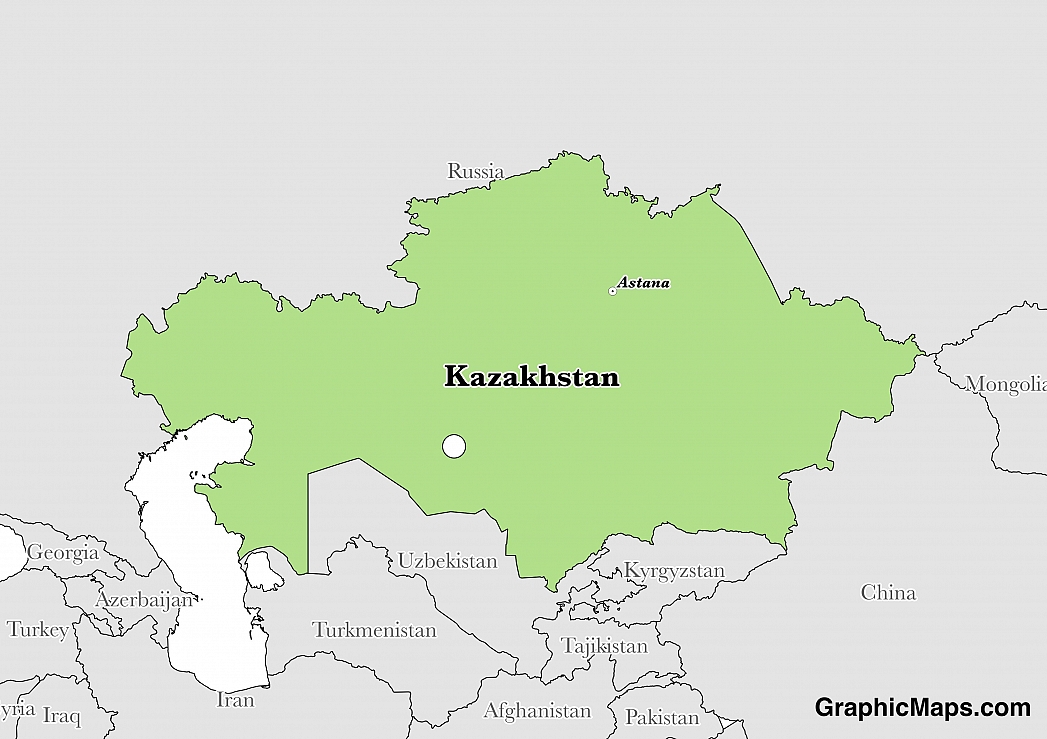Where is Kazakhstan?
Located in Central Asia, Kazakhstan has a 13,364.00 km border with China (1,765 km), Kyrgyzstan (1,212 km), Russia (7,644 km), Turkmenistan (413 km) and Uzbekistan (2,330 km). Kyrgzstan has yet to ratify the 2001 boundary delimitation with Kazakhstan.
The capital city of Kazakhstan is Astana. It has been the capital of the country since 1998. Initially, the country capital was situated in a city called Almaty. The capital of the state was moved from Almaty to Astana because of vast limitations that faced Almaty. Astana was made the capital by the exercise of the presidential decree as stated in the country's constitution. The advantages of crowning Astana as the capital included its geographical location, i.e., the city can expand without facing many geographic and physical barriers. Astana houses more than 128,000 businesses which range from small to large businesses enterprises. The design of the city was made by an expert called Nursultan Nazarbayev. The designer combined the traditional structural models from both the west and east worlds.
Read more on Kazakhstan's CapitalKazakhstan is an Asian country covering 2,724,900.00 km2 of which 0.92% is water and 2,699,700.00 km2 is land. This makes it the 9th largest country in the world and slightly less than four times the size of Texas. Its geographic coordinates are 48 00 N, 68 00 E and Astana is the capital city.
The name "Kazakh" comes from the Turkic word "kaz", which means "to wonder".
Its ISO code is KZ.
Geography
Kazakhstan has a mean elevation of 387 m above sea level.
It has a continental climate with cold winters and hot summers. Its terrain is vast, with flat steppes, mountains, and plains.
Population
Kazakhstan has a population of 18,360,353 making it the 62nd largest in the world. The majority of the population lives in the far northern and southern portions of the country.
Kazakh is the official language, as is Russian. The major ethnic group is Kazakh, followed by Russian. The majority of the population is Muslim, with a significant Christian minority.
The official language of Kazakhstan is Kazakh. Russian is also widely spoken. Other languages spoken in the country include German, which is spoken by 958,000 people, and tajki Tatar who has 328,000 speakers. Other minority languages include Dungan, Ili Turki, English and the Sinte Romani. The Kazakh language belongs to a branch of Kipchak and Turkic languages. The linguistic family of the Kipchak and Turkik share the same origin as the Nogai and Kyrgyz. Kazakh is spoken in an area spanning the state of Kazakhstan, as well as parts of Russia and Kyrgyzstan. The writing system is an adoption of the Kazakh alphabet which also includes the Latin and Cyrillic scripting as well as Arabic and Kazakh Braille.
Read more on Kazakhstan's LanguagesThe dialing code for the country is 7.
Government
Kazakhstan is an independent country. It gained independence with the dissolution of the Soviet Union in 1991. Its constitution was last ratified in 1995.
Kazakhstan is an independent country located in central Asia. Its government comprises of the executive, judiciary and the representatives. For each of the leaders to occupy an office in Kazakhstan, they have to go through a very tough election process where the citizen vote and decide the kind of leaders they wish to lead them. According to Kazakhstan's electoral laws and regulations, the president can only operate in office for two terms of five years.
Read more on Kazakhstan's GovernmentEconomy
Factoring in Purchasing Power Parity, Kazakhstan's GDP is $469,000,000,000.00 (USD) with $25,700.00 (USD) per capita. This makes it the 41st largest economy and its citizens the 70th richest in the world. The currency of Kazakhstan is the Tenge (KZT).
Its major export partners are China, Russia, and France. Its main exports are oil natural gas, ferrous metals, and chemicals. Its major import partners are Russia, China, and Germany. Its major imports include machinery and equipment, metal products, and foodstuffs.
Flag
The national flag of the independent state of Kazakhstan contains a golden sun on it, with 32 rays emanating from the sun. The blue background represents the ancient Russian art, tradition and cultural practices of the inhabitants of the region who were known as the Khanate people. The rays emanating from the sun is a representation of the steppes of grain which are considered to be a symbol of abundance and prosperity. The designer of Kazakhstan's flag was Shaken Onlasynovich Niyazbekov, an artist and designer who sent a proposal to design the nation's flag. He was chosen among 600 contestants who had applied for the project.
Read more on Kazakhstan's FlagThis page was last modified on January 17th, 2018
More on Graphicmaps

Published on 2019-11-06
What is a Trade Embargo?

Published on 2019-11-04
Which Two Countries Used to Have the Same Flag?

Published on 2019-09-16
What Is the Only Two-Sided State Flag?

Published on 2019-09-16
Which Country Flag Looks Like the Texas Flag?

Published on 2019-08-29
Flags That Resemble the US Flag

Published on 2019-08-20
